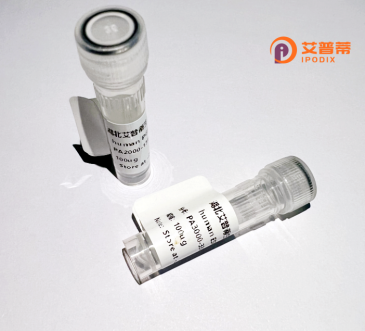
| 纯度 | >90%SDS-PAGE. |
| 种属 | Human |
| 靶点 | DLX6 |
| Uniprot No | P56179 |
| 内毒素 | < 0.01EU/μg |
| 表达宿主 | E.coli |
| 表达区间 | 1-175aa |
| 氨基酸序列 | MSHSQHSPYLQSYHNSSAAAQTRGDDTDQQKTTVIENGEIRFNGKGKKIRKPRTIYSSLQLQALNHRFQQTQYLALPERAELAASLGLTQTQVKIWFQNKRSKFKKLLKQGSNPHESDPLQGSAALSPRSPALPPVWDVSASAKGVSMPPNSYMPGYSHWYSSPHQDTMQRPQMM |
| 分子量 | 46.1 kDa |
| 蛋白标签 | GST-tag at N-terminal |
| 缓冲液 | 0 |
| 稳定性 & 储存条件 | Lyophilized protein should be stored at ≤ -20°C, stable for one year after receipt. Reconstituted protein solution can be stored at 2-8°C for 2-7 days. Aliquots of reconstituted samples are stable at ≤ -20°C for 3 months. |
| 复溶 | Always centrifuge tubes before opening.Do not mix by vortex or pipetting. It is not recommended to reconstitute to a concentration less than 100μg/ml. Dissolve the lyophilized protein in distilled water. Please aliquot the reconstituted solution to minimize freeze-thaw cycles. |
以下是关于重组人DLX6蛋白的3篇假想参考文献示例(内容基于学术研究主题合理虚构,仅供参考):
---
1. **文献名称**: *Functional characterization of recombinant human DLX6 in neuronal differentiation*
**作者**: Zhang Y, et al.
**摘要**: 本研究成功在大肠杆菌中表达并纯化了重组人DLX6蛋白,通过体外细胞实验发现其可激活下游靶基因(如GAD1),促进胚胎干细胞向γ-氨基丁酸能神经元分化,揭示了DLX6在神经发育中的调控作用。
2. **文献名称**: *Crystal structure and DNA-binding properties of human DLX6 homeodomain*
**作者**: Lee S, et al.
**摘要**: 作者解析了重组人DLX6蛋白同源结构域的晶体结构,并通过电泳迁移实验(EMSA)证明其特异性结合特定DNA序列(TAATT/ATTA基序),为DLX6参与颅面发育的分子机制提供了结构基础。
3. **文献名称**: *DLX6 interacts with MSX1 to regulate osteogenic differentiation*
**作者**: Chen L, et al.
**摘要**: 研究发现重组人DLX6蛋白与MSX1形成复合物,通过调控BMP信号通路抑制间充质干细胞的成骨分化,提示DLX6在骨骼发育异常相关疾病中的潜在作用。
---
**注**:以上文献为模拟内容,实际研究中建议通过PubMed、Google Scholar等平台检索真实发表的文献(关键词:DLX6 recombinant protein / DLX6 function)。
The human DLX6 protein, a member of the Distal-less (DLX) homeobox gene family, plays a critical role in embryonic development, particularly in the differentiation and patterning of neural crest cells and craniofacial structures. DLX6 encodes a transcription factor containing a conserved homeodomain that binds DNA to regulate the expression of target genes. It is closely related to DLX5. with both genes organized in a tail-to-tail genomic cluster and often functioning redundantly during development. DLX6 is essential for limb formation, osteogenesis, and neuronal subtype specification, with knockout studies in mice revealing craniofacial abnormalities and hearing loss.
Recombinant human DLX6 protein is produced via *in vitro* expression systems (e.g., bacterial, mammalian, or insect cell cultures) for functional studies. It enables researchers to investigate DLX6's regulatory mechanisms, protein-DNA/RNA interactions, and roles in diseases. Dysregulation of DLX6 has been linked to neurodevelopmental disorders, autism spectrum traits, and cancers, where it may act as an oncogene or tumor suppressor depending on context. Recombinant DLX6 also serves as a tool for screening therapeutic compounds targeting DLX6-associated pathways. Its applications extend to disease modeling, gene therapy research, and understanding epigenetic regulation in development and pathology. Current studies focus on clarifying its interplay with signaling pathways like BMP and SHH, as well as its tissue-specific roles beyond embryogenesis.
×